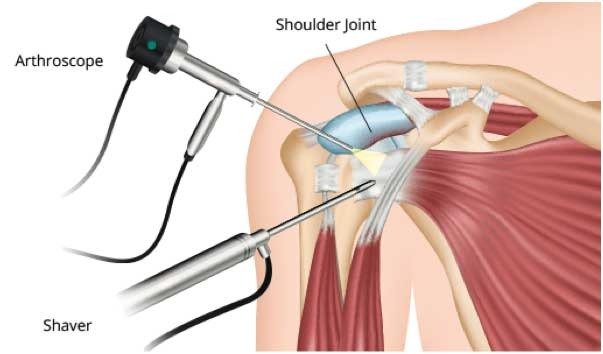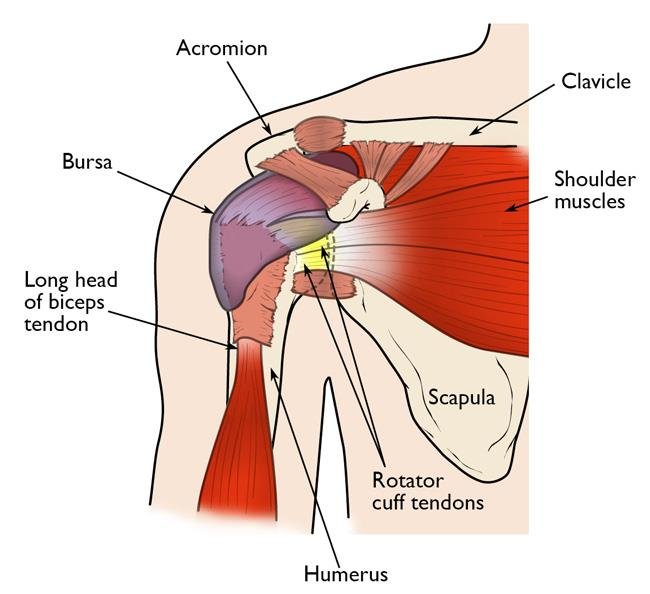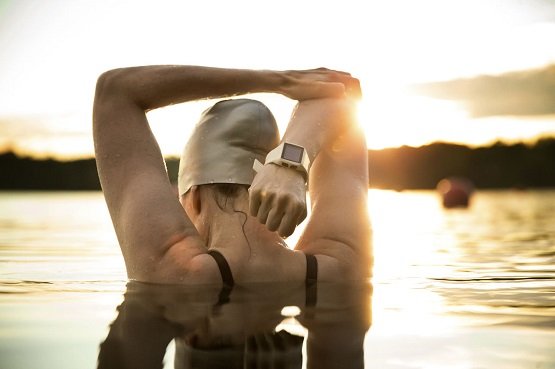Shoulder Arthroscopy

Ball and socket : The head of your upper arm bone fits into a rounded socket in your shoulder blade. This socket is called the glenoid. A slippery tissue called articular cartilage covers the surface of the ball and the socket. It creates a smooth, frictionless surface that helps the bones glide easily across each other.
Shoulder capsule. The joint is surrounded by bands of tissue called ligaments. They form a capsule that holds the joint together. The undersurface of the capsule is lined by a thin membrane called the synovium. It produces synovial fluid that lubricates the shoulder joint.

Common arthroscopic procedures include:
- Rotator cuff repair
- Removal or repair of the labrum
- Repair of ligaments
- Removal of inflamed tissue or loose cartilage
- Repair for recurrent shoulder dislocation
Positioning and Preparation
Once in the operating room, you will be positioned so that your surgeon can easily adjust the arthroscope to have a clear view of the inside of your shoulder. The two most common patient positions for arthroscopic shoulder surgery are:
- Beach chair position. This is a semi-seated position similar to sitting in a reclining chair.
- Lateral decubitus position. In this position the patient lies on his or her side on an operating table.
Each position has some slight advantages. Surgeons select positions based on the procedure being performed, as well as their individual training.
Once you are positioned, the surgical team will remove hair, if needed, and then spread an antiseptic solution over your shoulder to clean the skin. They will cover your shoulder and arm with sterile drapes, and will most likely place your forearm in a holding device to ensure your arm stays still.
Procedure
Shoulder arthroscopy is a type of keyhole surgery used to diagnose and treat problems inside your shoulder. It’s carried out through small cuts in your skin. Your surgeon uses a tiny camera to look inside your shoulder joint to diagnose problems and guide the repair of any damage.
Your doctor may suggest a shoulder arthroscopy if you have damage from an injury, arthritis or certain other health conditions.

Preparing for shoulder arthroscopy
Your surgeon will explain how to prepare for your procedure. If you smoke, for example, you will be asked to stop. Smoking increases your risk of getting a chest or wound infection, which can slow down your recovery. It can also make your surgery less effective and lead to complications.
Shoulder arthroscopy is usually done as a day-case procedure in a hospital. This means you have the procedure and go home on the same day.
You will usually have a general anaesthetic for a shoulder arthroscopy. This means you’ll be asleep during the operation. Sometimes, your surgeon may use a combination of both local and general anaesthetics. You have the procedure under general anaesthetic, but your surgeon injects a local anaesthetic before you wake up, to help control pain in your shoulder afterwards.
If you can’t have a general anaesthetic for any reason, your surgeon may be able to do your arthroscopy using a nerve block. This means having an injection of local anaesthetic around the nerves that control the shoulder. It makes your arm completely numb. You won’t feel anything during the procedure but you will be awake. Ask your surgeon if you would like something to make you drowsy and help you relax.
If you’re having a general anaesthetic, you’ll be given instructions about not eating or drinking for a certain number of hours before your surgery. This is for your own safety while you’re under anaesthetic so it’s important to follow your anaesthetist’s advice.
Your surgeon will discuss with you what will happen before, during and after your procedure, including any pain you might have. If you’re unsure about anything, don’t be afraid to ask. It’s important that you feel fully informed so you feel happy to give your consent for the procedure to go ahead. Your surgeon will ask you to do this by signing a consent form.
What happens during shoulder arthroscopy?
Once the anaesthetic has worked, your surgeon will make small cuts in the skin around your shoulder joint. They’ll then put the arthroscope in through one of these. This contains a tiny camera that your surgeon can use to look inside your shoulder joint. They may inject some saline (salt water) into your joint to help them get a clearer look.
Your surgeon will examine your shoulder joint by looking at images from the camera on a monitor. If there’s any damage in your shoulder, they’ll use surgical instruments to repair it. Your surgeon will also remove any damaged tissue that stops you moving your shoulder properly and causes pain.
Afterwards, your surgeon will close the cuts with stitches or adhesive strips. They’ll then wrap a dressing and a bandage around your shoulder.
What to expect afterwards
You’ll need to rest until the effects of the anaesthetic have worn off. You may have some discomfort as the anaesthetic wears off. Do tell your nurse so that you can have the pain relief you need.
You’ll usually be able to go home when you feel ready. You’ll need to arrange for someone to drive you home. If you live alone, you must have a responsible adult to stay with you for the first 24 hours.
Having a general anaesthetic or sedative affects everyone differently. You may find that you’re not so coordinated or that it’s difficult to think clearly. This should pass within 24 hours. In the meantime, don’t drive, drink alcohol, operate machinery or sign anything important. Always follow your surgeon’s advice.
Your nurse will give you some advice about caring for your wounds before you go home. They should explain about how and when the stitches will be removed if they need to be. This would usually happen around 10 to 14 days after the operation, and you’ll be told who will do this. You may also be given a date for a follow-up appointment with your surgeon
Recovering from shoulder arthroscopy
If you had a local anaesthetic injection, it may be up to 48 hours before the feeling comes back completely into your shoulder. You may not be fully aware where your arm is, so take special care not to injure it. You may be advised to keep your arm in a sling after the operation. This will keep your shoulder in the correct position to recover properly and protect it from further damage. Your surgeon will tell you how long you need to wear a sling for.
Your shoulder joint is likely to feel sore and stiff after surgery. Some people find lying down at night pulls their shoulder and is uncomfortable. You may find it more comfortable to sleep propped up at first, either in bed or in a reclining chair.
You may struggle to dress and wash yourself at first – you may want to ask your partner, a relative or friend to be on hand to help you. The first few weeks will be the most difficult – it should start to get easier after this.
You might have some pain or discomfort for several weeks after your shoulder arthroscopy. You may be given some painkillers to take home when you leave hospital. Or you can take over-the-counter painkillers such as paracetamol or ibuprofen. Always read the patient information leaflet that comes with your medicine. If you have any questions, ask your pharmacist for advice. Applying a cold compress such as an ice pack or a bag of frozen peas wrapped in a towel may help to reduce swelling and bruising. But don’t apply ice directly to your bare shoulder as it can damage your skin.
Your physiotherapist will recommend some exercises for you and advise you when to start doing them. Doing these regularly will help your shoulder to heal and may help you to recover more quickly.
Depending on what was involved in your procedure, it can take several weeks to several months to recover from shoulder arthroscopy. Most people regain full movement of their shoulder afterwards, but this can take several months. Ask your surgeon if you have any queries about re-starting specific activities, and always follow their advice.
Side-effects
Side-effects are the unwanted but mostly temporary effects that you may have after a procedure. Some specific side-effects of shoulder arthroscopy are:
- small scars on your shoulder, where the surgeon made the small cuts to put in the camera and instruments
- pain and stiffness around your shoulder
How long pain and stiffness will take to go is very individual. Your exercises will help you to regain movement, strengthen your shoulder and get rid of stiffness.
What are the alternatives to shoulder arthroscopy?
Shoulder arthroscopy may be used to diagnose shoulder problems, or to treat them.
Diagnosis
Not everyone who has a problem with their shoulder will need to have an arthroscopy. Your doctor will usually be able to diagnose your shoulder problem by examining you. You may also need to have some imaging tests, such as an X-ray, an ultrasound or a magnetic resonance imaging (MRI) scan.
Treatment
The best treatment for your shoulder problem will depend on:
- how much damage there is to your shoulder
- how long your shoulder has been troublesome
- how much it affects you day-to-day
Sometimes, your symptoms will improve on their own without any surgical treatment. Your doctor may suggest ice packs and anti-inflammatory medicines, as well as stretching exercises. Once you are able to move your shoulder again without pain, you can start exercises to strengthen the muscles around your shoulder. This is usually around four weeks later. Your doctor may refer you to a physiotherapist for help with the exercises. Another treatment that can be helpful for shoulder problems is a steroid injection. Talk to your doctor about which treatment options are the right ones for you.



